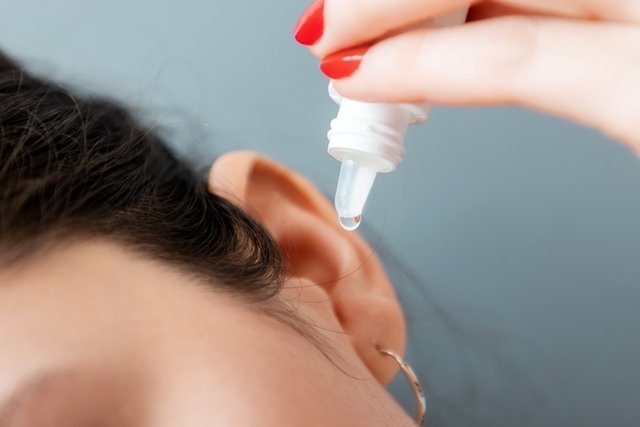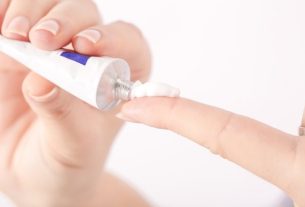Some remedies for inflamed ears, such as ketoprofen, dexamethasone or dexbronpheniramine + pseudoephedrine, help reduce inflammation and relieve symptoms such as pain or discomfort in the ear, caused by otitis externa or media.
Furthermore, if the inflammation in the ear was caused by bacteria, the doctor may recommend the use of antibiotics in the form of tablets or drops to be applied to the ear, such as amoxicillin + clavulanate or gentamicin, for example.
Treatment for an inflamed ear must be carried out with the advice of an otorhinolaryngologist, who can recommend the best medicine according to the type and cause of the inflammation. See the main causes of inflamed ears.
11 remedies for inflamed ears
The main remedies for inflamed ears are:
1. Cetoprofen
Ketoprofen is an anti-inflammatory and analgesic that reduces ear inflammation and is recommended for ear pain caused by otitis.
This medicine can be found in the form of 50, 100 or 150 mg tablets, or 20 mg/mL oral solution in drops that must be taken orally, during a meal.
Ketoprofen oral drops can be used by children from 1 year of age and the tablets should only be taken by adults, being contraindicated in pregnancy.
How to use: The initial dose for adults is 1 tablet of 150 mg, twice a day. This dose can be reduced by the doctor to 1 tablet of 150 mg per day, depending on the improvement of symptoms. Find out how to give ketoprofen drops to children.
2. Dexamethasone
Dexamethasone in the form of a dermatological ointment is a potent corticosteroid that can be indicated for otitis externa, as long as there is no perforation of the eardrum.
This ointment can be found under the name Dexason 1 mg/g, and should not be used in cases of ear fungus infection, herpes simplex or during pregnancy.
How to use: clean and dry the outside of the ear well. Apply dexamethasone ointment to a cotton pad and apply it to the walls of the external ear canal, 2 or 3 times a day, as instructed by the otorhinolaryngologist. See how to use dexamethasone ointment correctly.
3. Amoxicillin + clavulanate
Amoxicillin + clavulanate is an antibiotic that may be recommended by an otolaryngologist for inflamed ears in the case of otitis media, caused by bacteria.
This medicine can be found in the form of tablets or oral suspension, as a generic or under the trade names Clavulin BD, Novamox or Atak Clav, for example.
How to use: the normally recommended dose for adults or children over 12 years of age is 1 tablet of amoxicillin 500 mg + clavulanate 125 mg, every 8 hours, or 1 tablet of amoxicillin 875 + clavulanate 125 mg, every 12 hours, depending on guided by the doctor. Find out how to take amoxicillin and amoxicillin + clavulanate.
4. Ciprofloxacin
Ciprofloxacin is a broad-spectrum antibiotic from the fluoroquinolone class indicated for the treatment of ear inflammation caused by bacteria, as in the case of otitis media.
This medicine is available in the form of 500 mg tablets, as generic “ciprofloxacin hydrochloride”, or under the trade names Cipro, Prolox or Foritus, sold upon presentation of a medical prescription.
Ciprofloxacin should not be used by children, pregnant or breastfeeding women, or people with a history of tendon problems caused by the use of fluoroquinolones, or who have myasthenia gravis.
How to use: ciprofloxacin should be taken orally, with a glass of water, before or after a meal, and the normally recommended dose for adults is 250 mg to 500 mg, twice a day, or as per medical advice. Find out how to take and dosage of ciprofloxacin.
5. Dexbronfeniramina + pseudoefedrina
Dexbronpheniramine + pseudoephedrine is a medicine for ear inflammation indicated in cases of otitis media with secretion or obstruction of the Eustachian tube. See the main causes of ear discharge.
This remedy can be found in the form of capsules containing 6 mg of dexbronpheniramine maleate + 120 mg of pseudoephedrine sulfate, with the trade name Winter AP.
Dexbronpheniramine + pseudoephedrine should not be used by children under 12 years of age, pregnant or breastfeeding women, or people with glaucoma, heart problems, hyperthyroidism, diabetes or who use MAOI inhibitor medications.
How to use: the normally recommended dose for adults is 1 capsule, every 12 hours, or as advised by a doctor. The capsule should be taken with a glass of water, and the capsule should not be opened, broken or chewed.
6. Acetilcefuroxima
Axetilcefuroxime is an antibiotic from the cephalosporin class, indicated to eliminate bacteria such as S. pneumoniae, H. influenzae, S. pyogenes e M. catarrhalis, helping to alleviate the symptoms of bacterial otitis media. Understand what otitis media is.
This medicine can be found in the form of tablets for oral use, as the generic “axecilcefuroxime” or with the trade names Zinnat or Mefex, for example.
How to use: the normally recommended dose for adults is 1 tablet of 500 mg of axetilcefuroxime, once a day. For children aged 3 months to 12 years of age, axetilcefuroxime oral suspension should be used and the doses should be calculated by the pediatrician according to the child’s body weight.
7. Gentamicin + betamethasone
Gentamicin + betamethasone is a medicine for ear inflammation that helps eliminate bacteria, in addition to reducing inflammation, and is normally indicated in cases of acute or chronic otitis externa. Know how to identify the symptoms of otitis externa.
This remedy is found in the form of ear drops containing 3 mg/mL of gentamicin sulfate + 1 mg/mL of betamethasone disodium phosphate, under the trade name Garasone.
Gentamicin + betamethasone can be used by adults or children over 8 years of age, and is contraindicated in cases of fungal infections in the ear, absence or perforation of the eardrum, pregnancy or breastfeeding.
How to use: Clean the external ear canal carefully before applying ear drops. The recommended dose for adults is 3 to 4 drops in the ear, 2 to 4 times a day, or as advised by the otorhinolaryngologist.
8. Polymyxin B + lidocaine
Polymyxin B + Lidocaine is a medicine for ear inflammation that contains an antibiotic and anesthetic that help eliminate bacteria and relieve pain caused by acute otitis externa.
This medicine is available in the form of drops to be applied directly to the ear containing 12,000 IU/mL of polymyxin B sulfate + 45.4 mg/mL of lidocaine, under the trade name Lidosporin.
Polymyxin B + Lidocaine should not be used during pregnancy or breastfeeding, or by people who have fungal, viral, tuberculosis or herpes infections in the ear, perforation of the eardrum or otitis media.
How to use: clean and dry the affected external ear canal. Do not use soap or other products to clean the ear, as this may inactivate polymyxin B. The recommended dose for adults is 3 or 4 drops applied to the affected ear, 3 to 4 times a day, or as recommended by the otorhinolaryngologist.
9. Clorfenesina
Chlorphenesin + betamethasone + tetracaine hydrochloride is a medicine for ear inflammation caused by acute or chronic otitis externa, due to bacterial or fungal infections, or due to seborrheic dermatitis, allergic eczema and psoriasis.
This medicine contains betamethasone 1 mg/mL + chlorphenesin 10 mg/mL + tetracaine hydrochloride 5 mg/mL, and is available in the form of drops to be applied to the ear, under the trade name Oto Betnovate.
Chlorphenesin + betamethasone + tetracaine hydrochloride should not be used during pregnancy.
How to use: the recommended dose for adults is 3 to 4 drops applied to the affected ear, 3 to 4 times a day, for 7 to 10 days, as recommended by the otorhinolaryngologist. Before applying the drops, the external ear canal must be carefully cleaned and dried well.
10. Fluocinolona acetonida
The remedy for ear inflammation containing fluocinolone acetonide + polymyxin B sulfate + neomycin + lidocaine hydrochloride is indicated for the treatment of bacterial otitis externa.
This remedy works by eliminating bacteria and reducing the pain caused by otitis externa, and is found in the form of drops to be applied to the ear, under the trade name Otosylase.
Fluocinolone acetonide + polymyxin B + neomycin + lidocaine should not be used during pregnancy or breastfeeding, as well as in cases of otitis caused by fungi, viruses or herpes simplex, or perforation of the eardrum.
How to use: the dose for adults is 3 or 4 drops applied to the ear, 2 to 4 times a day, as advised by the otorhinolaryngologist.
11. Hialuronidase
The remedy for inflammation with hyaluronidase, contains other substances such as lidocaine and neomycin, and is indicated in cases of otitis media, as it has analgesic and antibacterial action.
This remedy is found in the form of drops to be applied to the ear, under the trade name Oto-Xilodase and should not be used for otitis caused by fungi or during pregnancy or breastfeeding.
How to use: The recommended dose for adults is 5 to 10 drops in the affected ear, 1 to 4 times a day, until the pain and infection disappear, as recommended by the otorhinolaryngologist. See also earache remedies.
Home remedy for inflamed ears
Some home remedies for ear inflammation caused by otitis externa, such as mullein essential oil or garlic and olive oil compress, can help reduce inflammation, relieving symptoms of pain or discomfort.
These home remedies can be used to complement the treatment recommended by the otorhinolaryngologist, and should be used with medical advice. See all home remedy options for otitis.

Sign up for our newsletter and stay up to date with exclusive news
that can transform your routine!
Warning: Undefined array key "title" in /home/storelat/public_html/wp-content/plugins/link-whisper-premium/templates/frontend/related-posts.php on line 12
Warning: Undefined array key "title_tag" in /home/storelat/public_html/wp-content/plugins/link-whisper-premium/templates/frontend/related-posts.php on line 13




